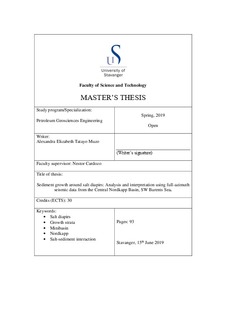| dc.contributor.advisor | Cardozo, Nestor | |
| dc.contributor.author | Tatayo, Alexandra | |
| dc.coverage.spatial | Norwegian Barents Sea, Norway | nb_NO |
| dc.date.accessioned | 2019-10-01T13:18:42Z | |
| dc.date.available | 2019-10-01T13:18:42Z | |
| dc.date.issued | 2019-06-15 | |
| dc.identifier.uri | http://hdl.handle.net/11250/2619657 | |
| dc.description | Master's thesis in Petroleum Geosciences Engineering | nb_NO |
| dc.description.abstract | The Nordkapp Basin (Norwegian Barents Sea) comprises a large number of salt structures developed during Late Paleozoic-Early Mesozoic. Salt diapirism is dominant in this basin, and it influences all aspects of the petroleum system. This thesis focuses on the analysis of the growth of four Triassic salt diapirs (D1-D4) that control the distribution of sediments in the central sub-basin of the Nordkapp basin. Salt-sediment interaction is analysed through Δd/d (d:depth) plots constructed from interpreted horizons on a full-azimuth seismic cube in the central sub-basin. The Δd/d technique allows (1) understanding the distribution and depositional environments of the Triassic sediments affected by the diapirs, (2) providing a growth history of the salt diapirs and, (3) identifying angular unconformities that can act as stratigraphic traps. The results indicate that although the four diapirs growth history is roughly common, not all diapirs formed at the same time and in the same way. Lower Triassic intervals show large salt evacuation that led mainly to the rise of diapirs D2 and D3 in the SE. Early to Middle Triassic minor salt movement resulted in the collapse of diapir D4 in the N. Middle Triassic-Jurassic intervals display depocenter migration, with diapirs D1 and D4 in the NW growing more than diapirs D2 and D3 in the SE. Late Triassic gliding and contractional diapirism generated teardrop diapirs. Shortening is recognized during the Cretaceous and Cenozoic, and it allowed the rejuvenation and growth of the diapirs. Middle Triassic fluvial systems (meandering and braided) were influenced by the diapirs growth. In places where diapir growth is high, these river channels divert and are far away from the diapir. On the contrary, in places where diapir growth is low, the channels are located close to the diapirs and even bypass them. Furthermore, knowing the history of the diapir growth may conduct to better constrains on its dimensions and surrounding stress field, which could reduce risk for drilling close to diapirs. These results have implications for hydrocarbon exploration since they can help predicting the location and timing of maximum growth, and the highest petroleum potential intervals. | nb_NO |
| dc.language.iso | eng | nb_NO |
| dc.publisher | University of Stavanger, Norway | nb_NO |
| dc.relation.ispartofseries | Masteroppgave/UIS-TN-IER/2019; | |
| dc.subject | petroleumsgeologi | nb_NO |
| dc.subject | Nordkapp Basin | nb_NO |
| dc.subject | salt diapir | nb_NO |
| dc.subject | salt-sediment interaction | nb_NO |
| dc.subject | growth strata | nb_NO |
| dc.subject | minibasin | nb_NO |
| dc.subject | petroleum geology | nb_NO |
| dc.title | Sediment growth around salt diapirs: Analysis and interpretation using full-azimuth seismic data from the Central Nordkapp Basin, SW Barents Sea | nb_NO |
| dc.type | Master thesis | nb_NO |
| dc.subject.nsi | VDP::Technology: 500::Rock and petroleum disciplines: 510::Geological engineering: 513 | nb_NO |
| dc.subject.nsi | VDP::Mathematics and natural science: 400::Geosciences: 450::Petroleum geology and petroleum geophysics: 464 | nb_NO |
